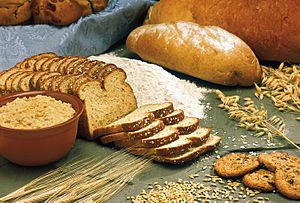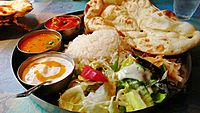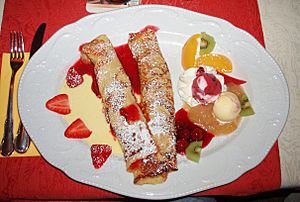Vegetarian cuisine facts for kids
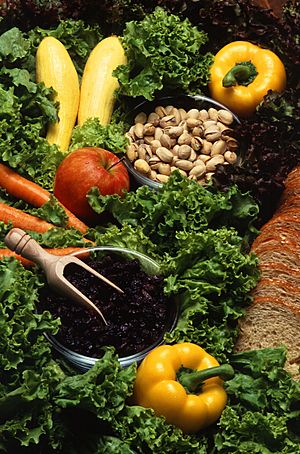
Vegetarian cuisine is all about food that follows vegetarian rules. This means it doesn't include meat or animal parts like gelatin. The most common type of vegetarianism in many Western countries is called Lacto-ovo vegetarianism. People who are lacto-ovo vegetarians eat eggs and dairy products like milk and cheese (as long as the cheese doesn't use animal-based rennet).
Other types include:
- Lacto vegetarianism: People eat dairy products but no eggs.
- Ovo vegetarianism: People eat eggs but no dairy products.
- Veganism: This is the strictest type. Vegans avoid all animal products, including dairy, honey, and some sugars if they are processed using animal parts.
- Partial vegetarians: Some people are "partial vegetarians." For example, pescetarians eat fish but no other meat.
There are many kinds of vegetarian foods. Some are made specially to replace meat in recipes. Others help make sure vegetarians get enough protein, B12 vitamin, and other important nutrients.
These foods include:
- Cereals, grains, fungi (like edible mushrooms), seaweed, fruits, vegetables, legumes, and nuts.
- Soy products like tofu and tempeh, which are great sources of protein.
- Textured vegetable protein (TVP), made from soy flour. It's often used in chili or burgers instead of ground meat.
- Meat analogues, which look and taste like meat. They are used in dishes that usually have meat.
- Vegan options for eggs and dairy, such as aquafaba (from chickpeas), plant cream, or plant milk.
Contents
Common Vegetarian Foods
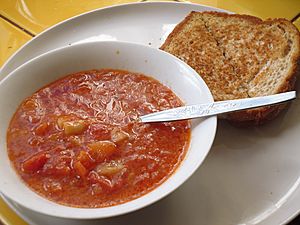
Foods that all vegetarians (including vegans) can usually eat include:
- Cereals and grains: Like barley, oats, quinoa, rice, and wheat. Also, products made from them, such as flour (for bread and pasta).
- Vegetables: Fresh, canned, frozen, or pickled. Also, vegetable sauces and vegetable oils.
- Edible fungi: Like mushrooms.
- Fruit: Fresh, canned, or dried. Also, products like jam.
- Legumes: Like beans (including soybeans and soy products like tofu), chickpeas, and lentils.
- Tree nuts and seeds: And products like nut butter.
- Herbs and spices.
- Other foods like seaweed-based products such as agar, which is like gelatin but from plants.
- Drinks like coffee, tea, or lemonade. Some beer and wine might use animal products to filter them, so not all are vegetarian.
Some foods are okay for most vegetarians but not for vegans:
- Dairy products: Like butter, cheese, milk, and yogurt. Vegans and pure ovo-vegetarians do not eat these.
- Eggs: Vegans and lacto-vegetarians (like most Indian vegetarians) do not eat these.
- Honey: Most vegans do not eat honey.
Vegetarians don't eat meat. But they also tend to eat more of certain healthy foods than non-vegetarians. These include:
- Fruits and vegetables
- Avocados and non-fried potatoes
- Whole grains and legumes
- Soy foods, nuts, and seeds
On the other hand, vegetarians often eat less of:
- Dairy products and eggs
- Refined grains
- Added fats
- Sweets and Snacks
- Sweetened drinks
This doesn't mean all vegetarians eat only healthy foods. A diet of just candy, for example, is technically vegetarian but wouldn't be healthy!
Traditional Vegetarian Cuisine
Many dishes around the world are naturally vegetarian. This means they don't need any special changes to fit a vegetarian diet. Here are some examples:
- In India, many traditional cuisines, especially those from Brahmin communities and the state of Gujarat, are strictly vegetarian. Some even avoid onion and garlic.
- Many dishes made with beans, pasta, potatoes, rice, stews, soups, and stir-fries are vegetarian.
- Breakfast foods like cereals, oatmeals, and granola bars.
- Fresh fruit and most salads.
- Dishes like potato salad, baba ganoush, pita-wraps, vegetable pilafs, and smoothies.
- Many sandwiches, such as cheese on toast, or cold sandwiches with roasted eggplant, mushrooms, bell peppers, and avocado.
- Side dishes like mashed potatoes, seasoned rice, and macaroni and cheese.
- Classical Buddhist cuisine in Asia, often found near temples, is usually vegetarian.
National Cuisines
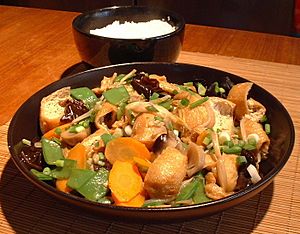
- Chinese and other East Asian dishes often use mushrooms, noodles, eggplant, string beans, broccoli, rice, and tofu.
- Georgian cuisine has many vegetarian options using eggplants, walnuts, kidney beans, mushrooms, and fresh herbs. Examples include ajapsandali and pkhali.
- Indian cuisine is full of vegetarian dishes due to religious traditions like Jain and Hindu faiths. Famous dishes include pakora, samosa, chana masala, and many subjis (vegetable dishes). South Indian foods like sambar and dosas are also often vegetarian.
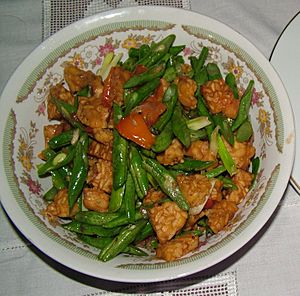
- In Indonesia, you'll find many vegetarian dishes like gado-gado and ketoprak. Fermented soy products like tempeh and tofu are common meat substitutes.
- Japanese foods like edamame, mochi, and vegetable sushi are often vegetarian. Miso soup can be made with vegetable stock instead of fish stock.
- Korean cuisine has dishes like bibimbap (rice with mixed vegetables) and jeon (pan-fried vegetables) that can be vegetarian.
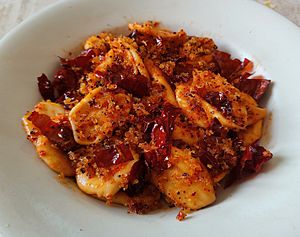
- Mediterranean foods include polentas and many tapas dishes.
- Mexican foods like salsa and guacamole with chips, rice and bean burritos, and many quesadillas are vegetarian.
- Italian foods like most pastas, many pizzas, bruschetta, and risottos are often vegetarian.
- Continental cuisine offers dishes like ratatouille, many quiches, and vegetable-stuffed mushrooms. In Germany, traditional dishes like Frankfurt green sauce and Klöße with vegetarian sauces are common.
- Many Greek and Balkan dishes, such as briam, dolmas (without meat), and spanakopita, are vegetarian.
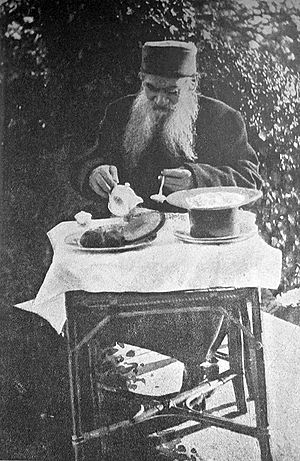
- Russian cuisine has a rich history of vegetarian dishes, partly due to Orthodox fasting traditions. Examples include vegetable borscht, pirogi, and blini.
- Many Ethiopian dishes like injeera with vegetable sauces are vegetarian.
- Mideastern food like falafel, hummus (mashed chickpeas), and tahini (ground sesame seeds) are popular vegetarian choices. Egyptian cuisine is especially rich in vegetarian foods, with national dishes like kushari and ful medames being entirely vegetarian.
- Many dishes in Thai cuisine can be made vegetarian by using tofu instead of meat.
- Creole and Southern foods like hush puppies, rice and beans, or sauteed kale can be vegetarian if not cooked with pork fat or meat stock.
- Some Welsh recipes, like Glamorgan sausages and Welsh rarebit, are vegetarian.
Desserts and Sweets
Most desserts are suitable for ovo-lacto vegetarians because they don't contain meat or fish. This includes pies, cakes, brownies, cookies, ice cream, and pudding. Eastern sweets like halva and Turkish delight are often vegan. Indian desserts are mostly vegetarian, made from milk products, like gulab jamun and rasgulla. Some dry fruit-based Indian sweets are even vegan.
Meat Analogues
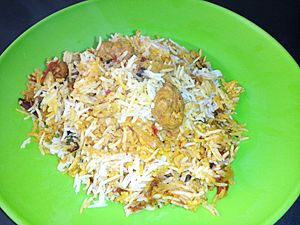
A meat alternative or meat substitute is a food product made from plants or other non-animal ingredients. People eat them instead of meat. These foods often try to be like real meat in how they feel in your mouth, how they taste, how they look, or their chemical makeup.
Meat alternatives often use soy (like tofu, tempeh, or textured vegetable protein). They can also be made from wheat gluten (called seitan), pea protein (like in the Beyond Burger), or mycoprotein (like Quorn).
People who are vegetarians or vegans often eat meat alternatives for dietary protein. Also, people who follow certain religious or cultural food rules use them. Lately, more people who eat meat sometimes (called flexitarians) are choosing meat alternatives. This is because they want to eat in a more earth-friendly way and reduce the impact of meat farming.
Meat substitutes have been around for a long time. Tofu was first made in China around 200 BCE. In the Middle Ages, people used chopped nuts and grapes instead of mincemeat during Lent. Since the 2010s, new companies like Impossible Foods and Beyond Meat have made plant-based versions of ground beef, burgers, and chicken nuggets very popular.Meat analogues are foods designed to look, taste, and feel like meat. They are often made from plant-based ingredients like soy or wheat protein. They are a popular choice for vegetarians and vegans who want to enjoy dishes that traditionally feature meat, such as burgers, sausages, or chicken nuggets, but without the actual meat.
Commercial Products

You can find many products made specifically for vegetarians in stores around the world. These products are often clearly labeled. For example, in Australia, many supermarkets offer vegetarian options. India has a very large market for vegetarian-labeled foods, with special government rules for "vegetarian" and "non-vegetarian" labels.
See also
 In Spanish: Gastronomía vegetariana para niños
In Spanish: Gastronomía vegetariana para niños


